Managing Communication: University of Bolton, Unit 5.5 Report
VerifiedAdded on 2023/06/10
|14
|1713
|251
Report
AI Summary
This report provides a comprehensive analysis of managing workplace communication, focusing on the University of Bolton as a case study. It examines the information and knowledge requirements of various stakeholders, including staff, students, faculty, and administrators, and explores systems used for communicating key information, such as meetings, briefings, emails, and letters. The report identifies potential barriers to effective workplace communication, including clarity of message, verbal communication issues, technological barriers, and interpersonal relationship challenges. Furthermore, it evaluates how communication is influenced by cultural values and explains how technology can both benefit and hinder the communication process. Finally, the report discusses the impact of policies and procedures, such as social media policies, on communication processes within the university. This document is available on Desklib, a platform offering study tools and resources for students.
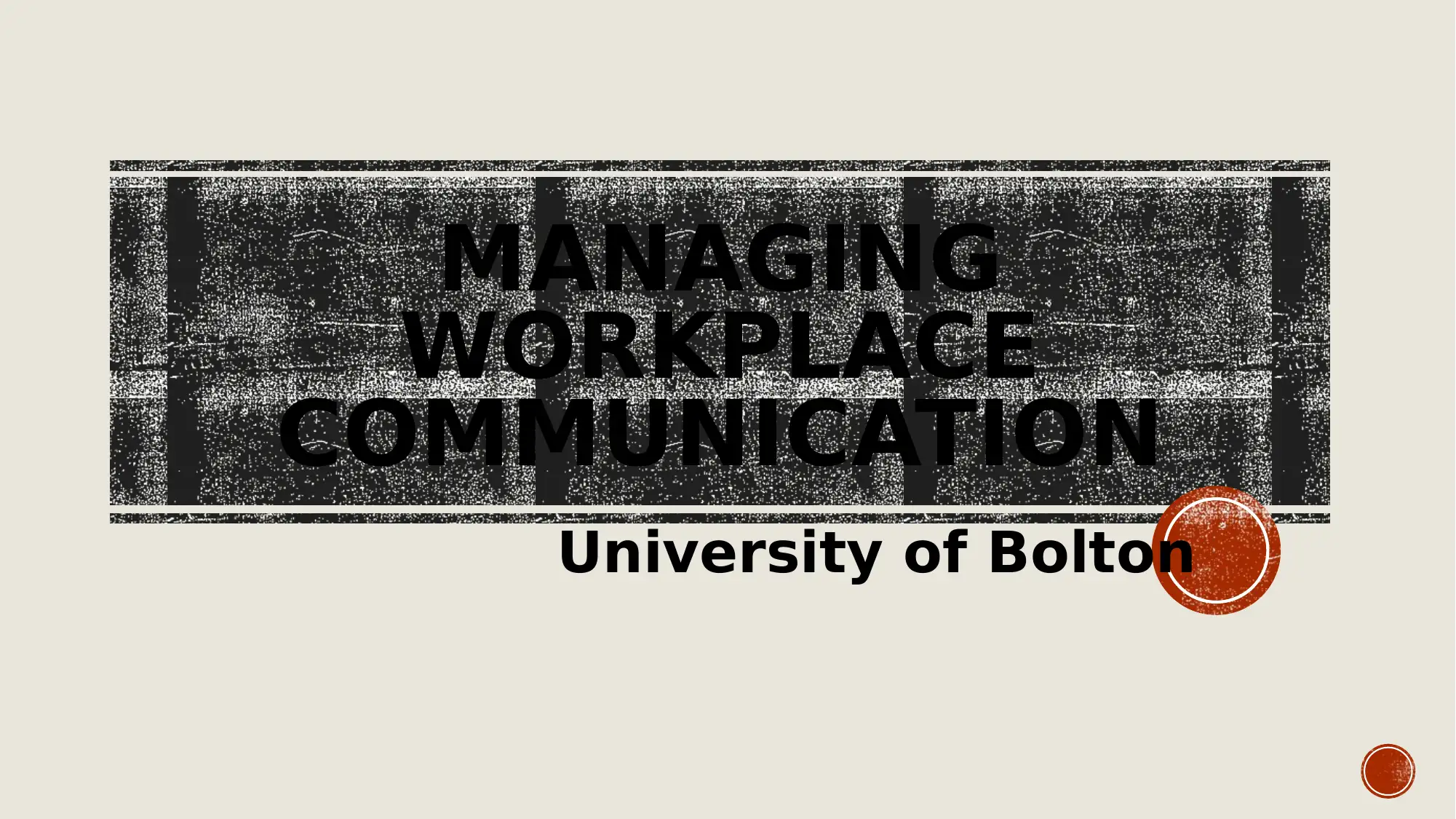
MANAGING
WORKPLACE
COMMUNICATION
University of Bolton
WORKPLACE
COMMUNICATION
University of Bolton
Paraphrase This Document
Need a fresh take? Get an instant paraphrase of this document with our AI Paraphraser
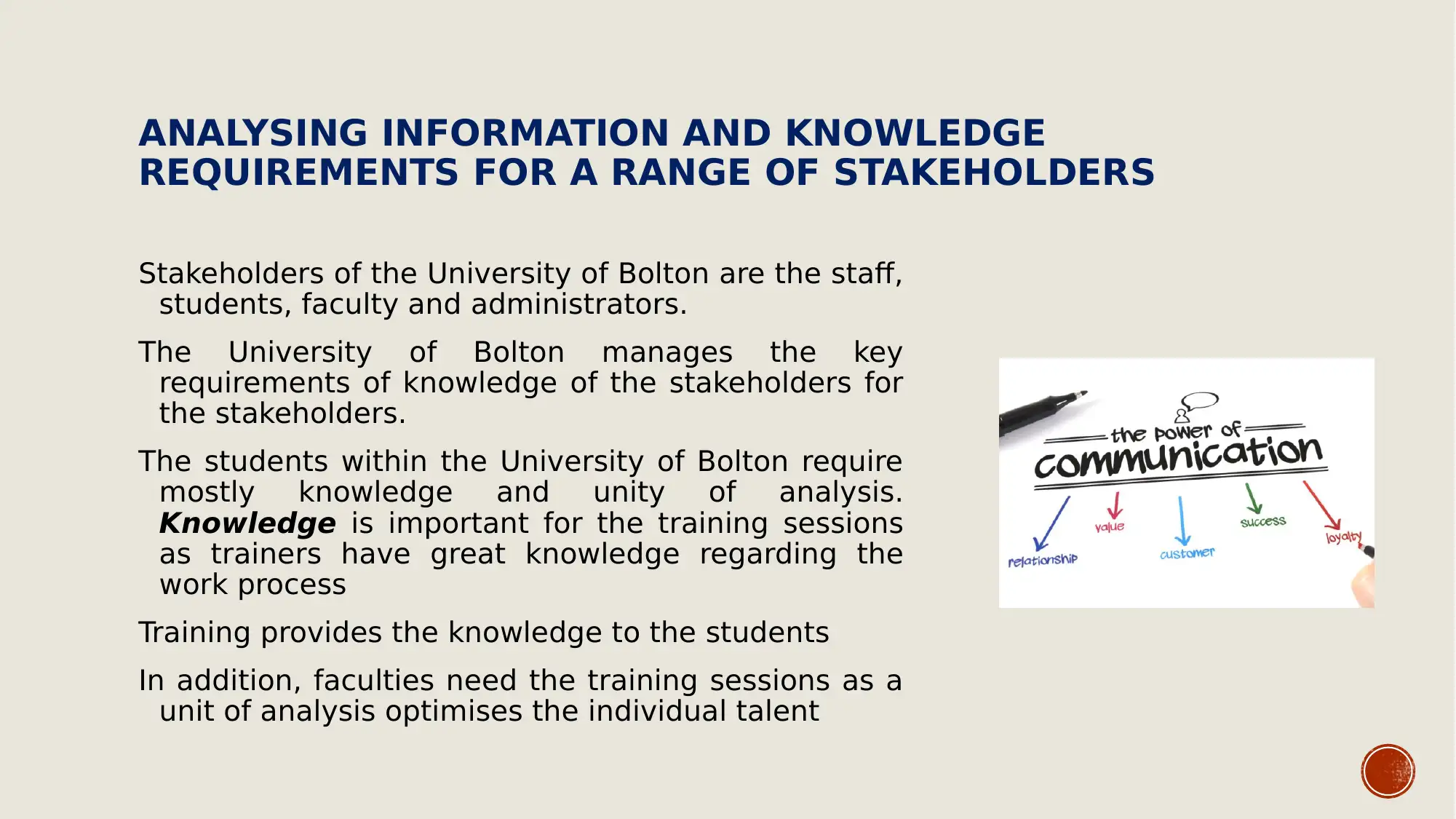
ANALYSING INFORMATION AND KNOWLEDGE
REQUIREMENTS FOR A RANGE OF STAKEHOLDERS
Stakeholders of the University of Bolton are the staff,
students, faculty and administrators.
The University of Bolton manages the key
requirements of knowledge of the stakeholders for
the stakeholders.
The students within the University of Bolton require
mostly knowledge and unity of analysis.
Knowledge is important for the training sessions
as trainers have great knowledge regarding the
work process
Training provides the knowledge to the students
In addition, faculties need the training sessions as a
unit of analysis optimises the individual talent
REQUIREMENTS FOR A RANGE OF STAKEHOLDERS
Stakeholders of the University of Bolton are the staff,
students, faculty and administrators.
The University of Bolton manages the key
requirements of knowledge of the stakeholders for
the stakeholders.
The students within the University of Bolton require
mostly knowledge and unity of analysis.
Knowledge is important for the training sessions
as trainers have great knowledge regarding the
work process
Training provides the knowledge to the students
In addition, faculties need the training sessions as a
unit of analysis optimises the individual talent
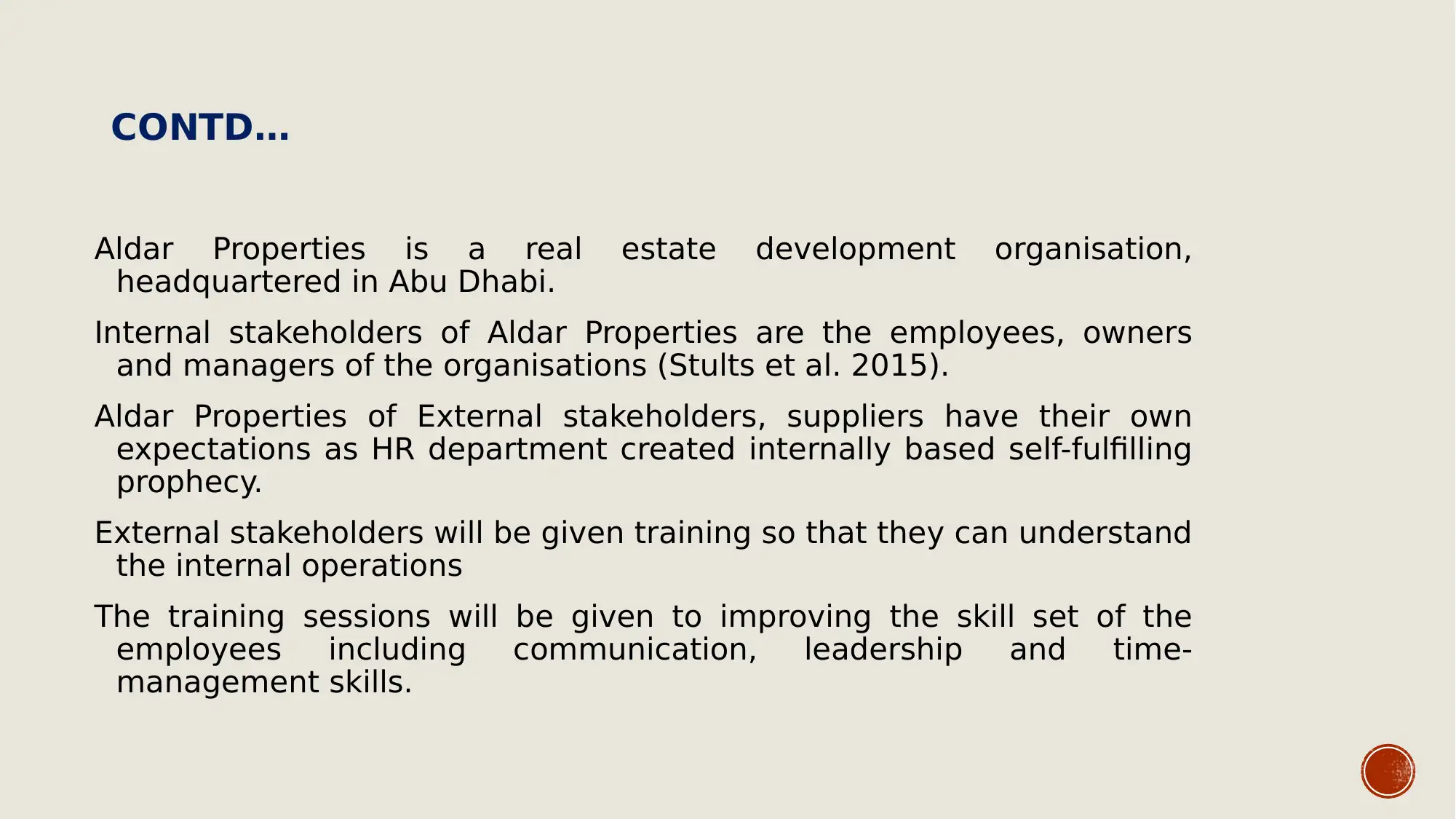
CONTD…
Aldar Properties is a real estate development organisation,
headquartered in Abu Dhabi.
Internal stakeholders of Aldar Properties are the employees, owners
and managers of the organisations (Stults et al. 2015).
Aldar Properties of External stakeholders, suppliers have their own
expectations as HR department created internally based self-fulfilling
prophecy.
External stakeholders will be given training so that they can understand
the internal operations
The training sessions will be given to improving the skill set of the
employees including communication, leadership and time-
management skills.
Aldar Properties is a real estate development organisation,
headquartered in Abu Dhabi.
Internal stakeholders of Aldar Properties are the employees, owners
and managers of the organisations (Stults et al. 2015).
Aldar Properties of External stakeholders, suppliers have their own
expectations as HR department created internally based self-fulfilling
prophecy.
External stakeholders will be given training so that they can understand
the internal operations
The training sessions will be given to improving the skill set of the
employees including communication, leadership and time-
management skills.
⊘ This is a preview!⊘
Do you want full access?
Subscribe today to unlock all pages.

Trusted by 1+ million students worldwide
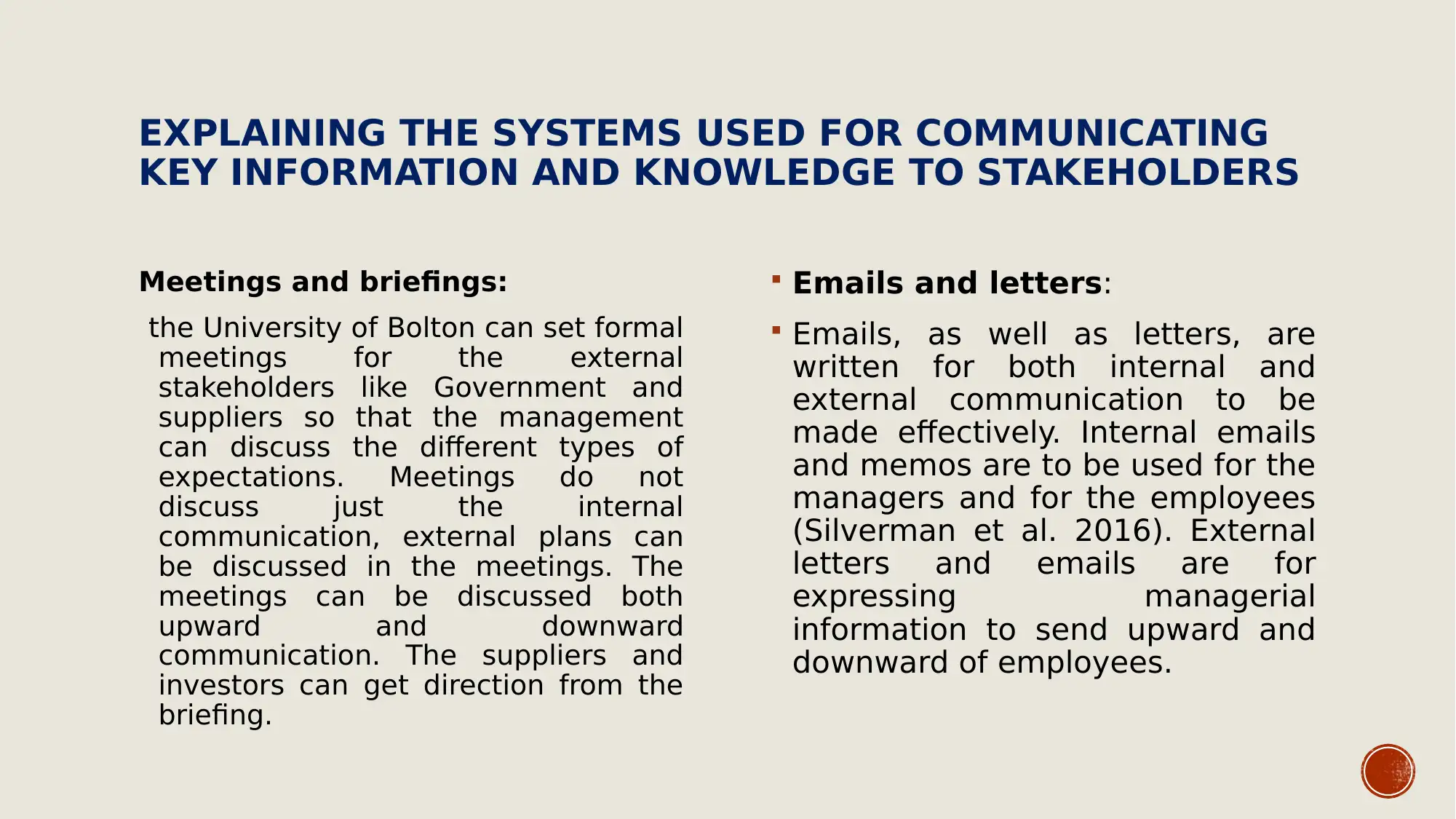
EXPLAINING THE SYSTEMS USED FOR COMMUNICATING
KEY INFORMATION AND KNOWLEDGE TO STAKEHOLDERS
Meetings and briefings:
the University of Bolton can set formal
meetings for the external
stakeholders like Government and
suppliers so that the management
can discuss the different types of
expectations. Meetings do not
discuss just the internal
communication, external plans can
be discussed in the meetings. The
meetings can be discussed both
upward and downward
communication. The suppliers and
investors can get direction from the
briefing.
Emails and letters:
Emails, as well as letters, are
written for both internal and
external communication to be
made effectively. Internal emails
and memos are to be used for the
managers and for the employees
(Silverman et al. 2016). External
letters and emails are for
expressing managerial
information to send upward and
downward of employees.
KEY INFORMATION AND KNOWLEDGE TO STAKEHOLDERS
Meetings and briefings:
the University of Bolton can set formal
meetings for the external
stakeholders like Government and
suppliers so that the management
can discuss the different types of
expectations. Meetings do not
discuss just the internal
communication, external plans can
be discussed in the meetings. The
meetings can be discussed both
upward and downward
communication. The suppliers and
investors can get direction from the
briefing.
Emails and letters:
Emails, as well as letters, are
written for both internal and
external communication to be
made effectively. Internal emails
and memos are to be used for the
managers and for the employees
(Silverman et al. 2016). External
letters and emails are for
expressing managerial
information to send upward and
downward of employees.
Paraphrase This Document
Need a fresh take? Get an instant paraphrase of this document with our AI Paraphraser
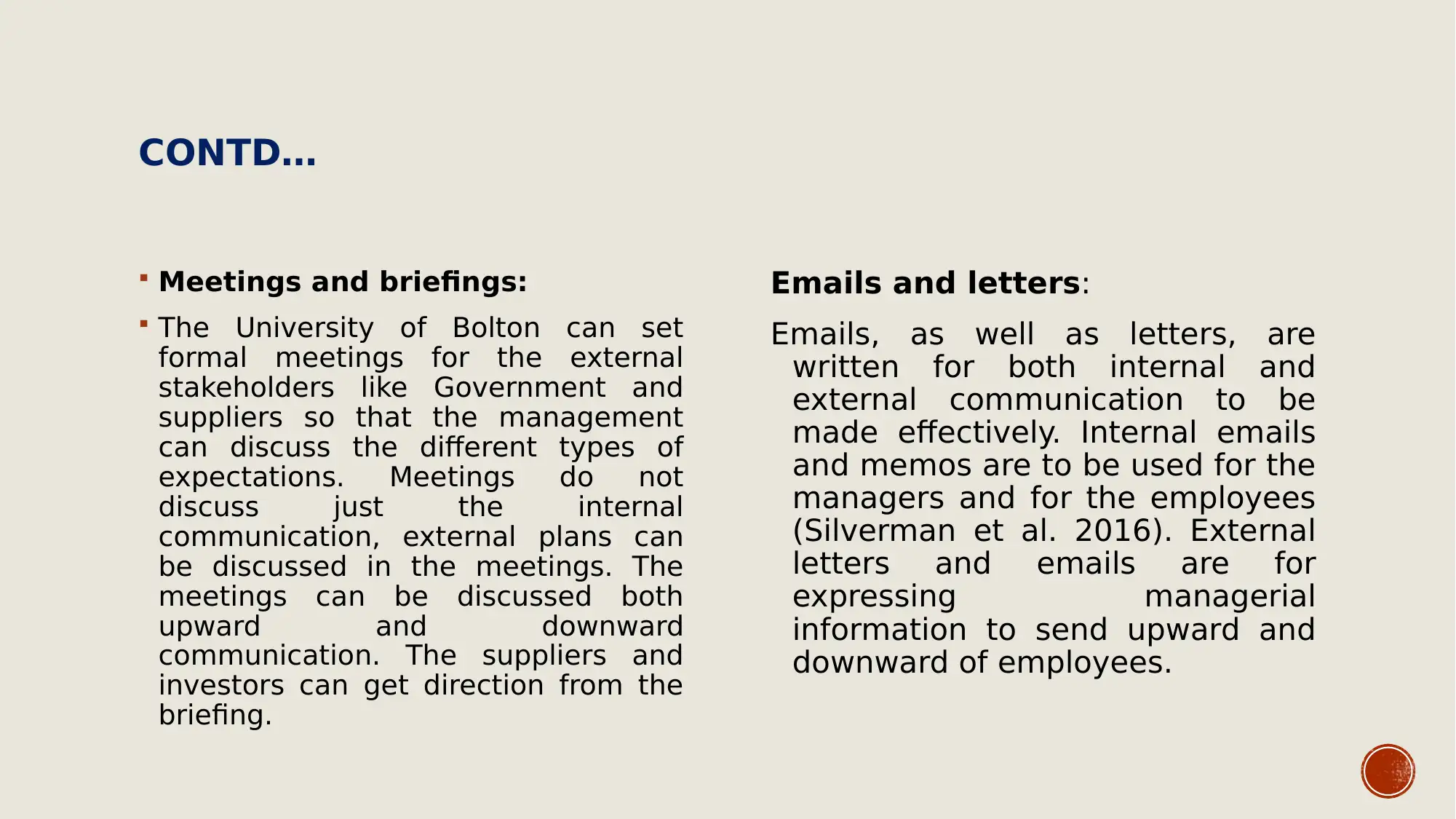
CONTD…
Meetings and briefings:
The University of Bolton can set
formal meetings for the external
stakeholders like Government and
suppliers so that the management
can discuss the different types of
expectations. Meetings do not
discuss just the internal
communication, external plans can
be discussed in the meetings. The
meetings can be discussed both
upward and downward
communication. The suppliers and
investors can get direction from the
briefing.
Emails and letters:
Emails, as well as letters, are
written for both internal and
external communication to be
made effectively. Internal emails
and memos are to be used for the
managers and for the employees
(Silverman et al. 2016). External
letters and emails are for
expressing managerial
information to send upward and
downward of employees.
Meetings and briefings:
The University of Bolton can set
formal meetings for the external
stakeholders like Government and
suppliers so that the management
can discuss the different types of
expectations. Meetings do not
discuss just the internal
communication, external plans can
be discussed in the meetings. The
meetings can be discussed both
upward and downward
communication. The suppliers and
investors can get direction from the
briefing.
Emails and letters:
Emails, as well as letters, are
written for both internal and
external communication to be
made effectively. Internal emails
and memos are to be used for the
managers and for the employees
(Silverman et al. 2016). External
letters and emails are for
expressing managerial
information to send upward and
downward of employees.
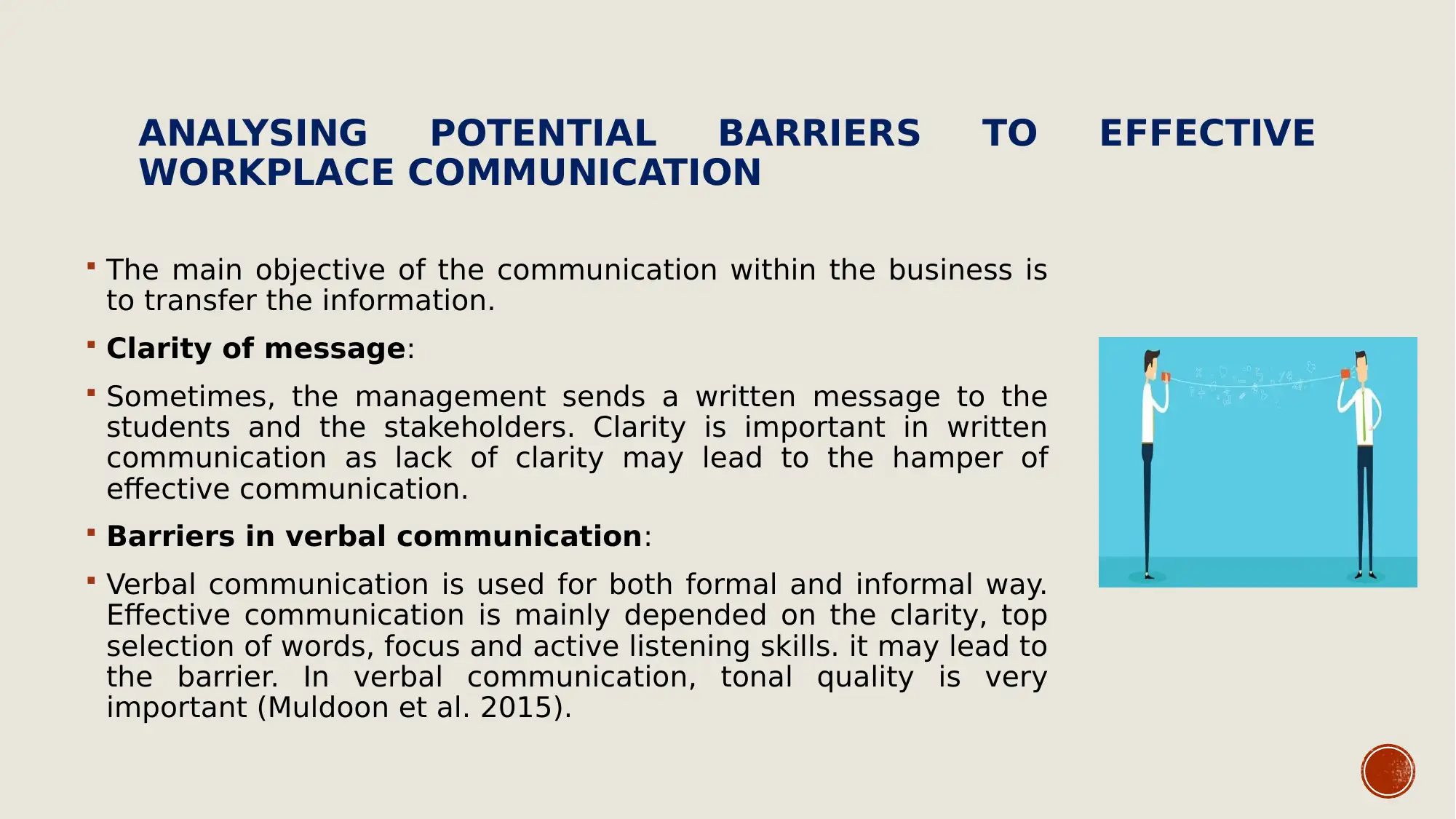
ANALYSING POTENTIAL BARRIERS TO EFFECTIVE
WORKPLACE COMMUNICATION
The main objective of the communication within the business is
to transfer the information.
Clarity of message:
Sometimes, the management sends a written message to the
students and the stakeholders. Clarity is important in written
communication as lack of clarity may lead to the hamper of
effective communication.
Barriers in verbal communication:
Verbal communication is used for both formal and informal way.
Effective communication is mainly depended on the clarity, top
selection of words, focus and active listening skills. it may lead to
the barrier. In verbal communication, tonal quality is very
important (Muldoon et al. 2015).
WORKPLACE COMMUNICATION
The main objective of the communication within the business is
to transfer the information.
Clarity of message:
Sometimes, the management sends a written message to the
students and the stakeholders. Clarity is important in written
communication as lack of clarity may lead to the hamper of
effective communication.
Barriers in verbal communication:
Verbal communication is used for both formal and informal way.
Effective communication is mainly depended on the clarity, top
selection of words, focus and active listening skills. it may lead to
the barrier. In verbal communication, tonal quality is very
important (Muldoon et al. 2015).
⊘ This is a preview!⊘
Do you want full access?
Subscribe today to unlock all pages.

Trusted by 1+ million students worldwide
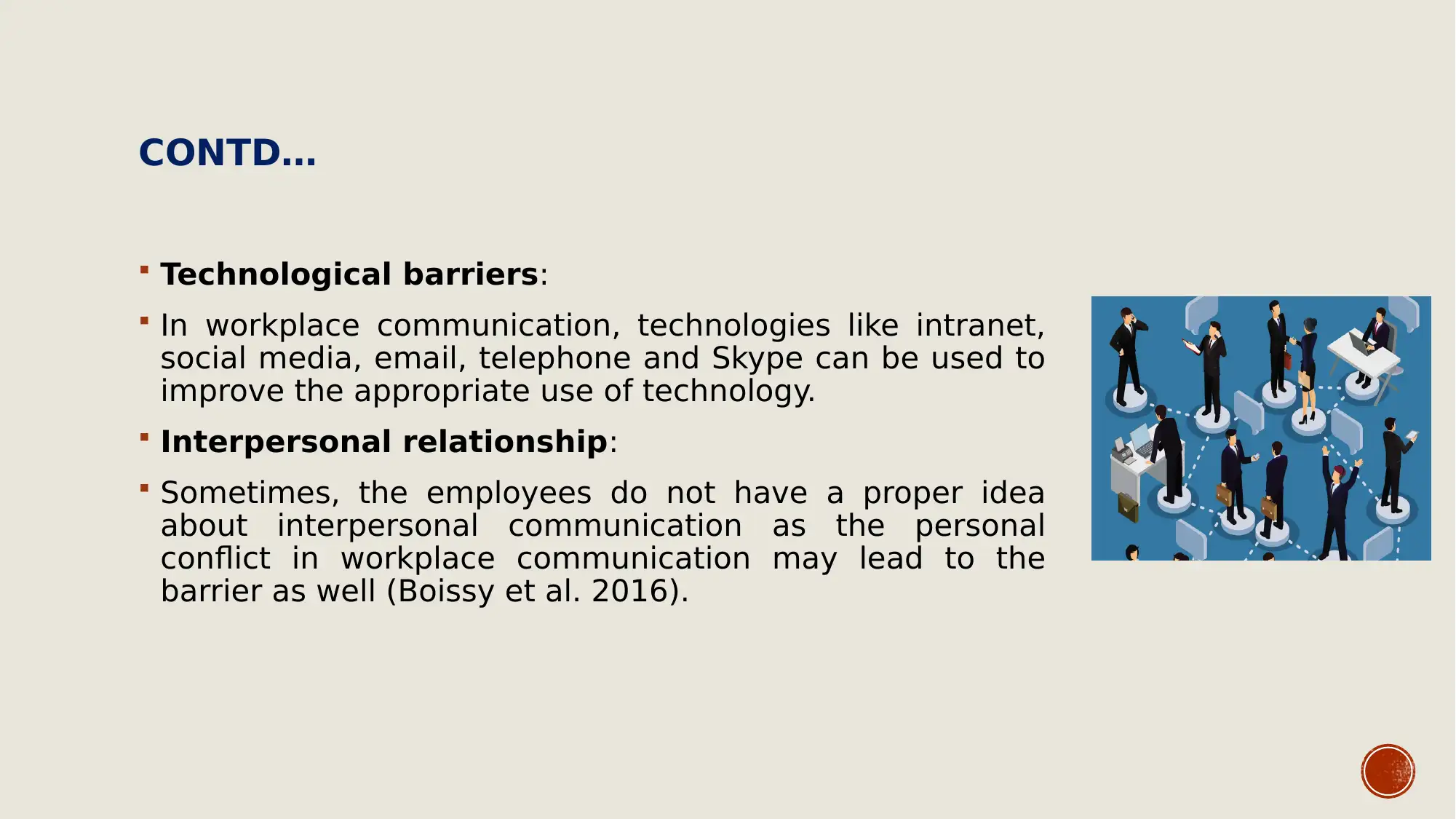
CONTD…
Technological barriers:
In workplace communication, technologies like intranet,
social media, email, telephone and Skype can be used to
improve the appropriate use of technology.
Interpersonal relationship:
Sometimes, the employees do not have a proper idea
about interpersonal communication as the personal
conflict in workplace communication may lead to the
barrier as well (Boissy et al. 2016).
Technological barriers:
In workplace communication, technologies like intranet,
social media, email, telephone and Skype can be used to
improve the appropriate use of technology.
Interpersonal relationship:
Sometimes, the employees do not have a proper idea
about interpersonal communication as the personal
conflict in workplace communication may lead to the
barrier as well (Boissy et al. 2016).
Paraphrase This Document
Need a fresh take? Get an instant paraphrase of this document with our AI Paraphraser
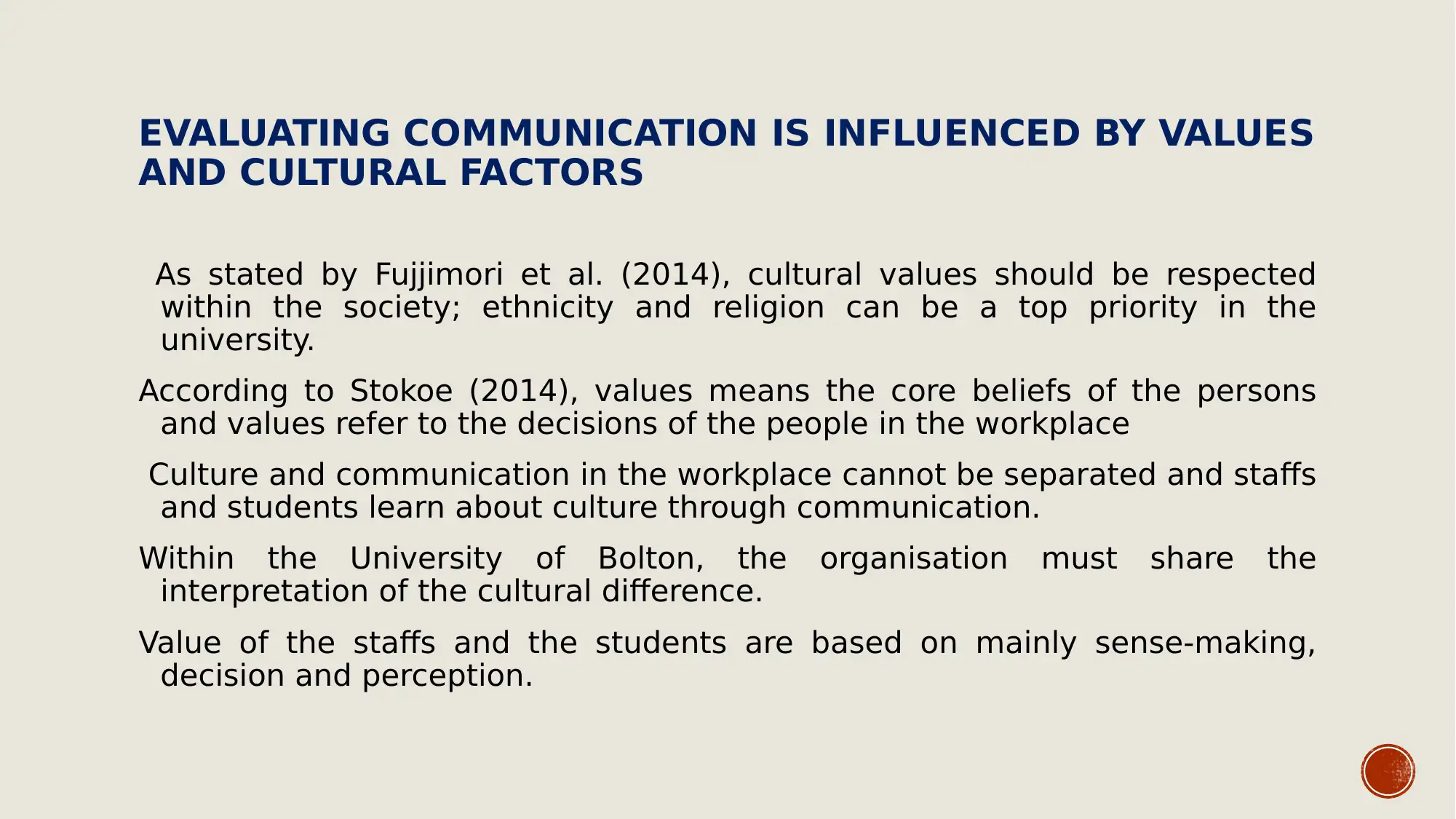
EVALUATING COMMUNICATION IS INFLUENCED BY VALUES
AND CULTURAL FACTORS
As stated by Fujjimori et al. (2014), cultural values should be respected
within the society; ethnicity and religion can be a top priority in the
university.
According to Stokoe (2014), values means the core beliefs of the persons
and values refer to the decisions of the people in the workplace
Culture and communication in the workplace cannot be separated and staffs
and students learn about culture through communication.
Within the University of Bolton, the organisation must share the
interpretation of the cultural difference.
Value of the staffs and the students are based on mainly sense-making,
decision and perception.
AND CULTURAL FACTORS
As stated by Fujjimori et al. (2014), cultural values should be respected
within the society; ethnicity and religion can be a top priority in the
university.
According to Stokoe (2014), values means the core beliefs of the persons
and values refer to the decisions of the people in the workplace
Culture and communication in the workplace cannot be separated and staffs
and students learn about culture through communication.
Within the University of Bolton, the organisation must share the
interpretation of the cultural difference.
Value of the staffs and the students are based on mainly sense-making,
decision and perception.
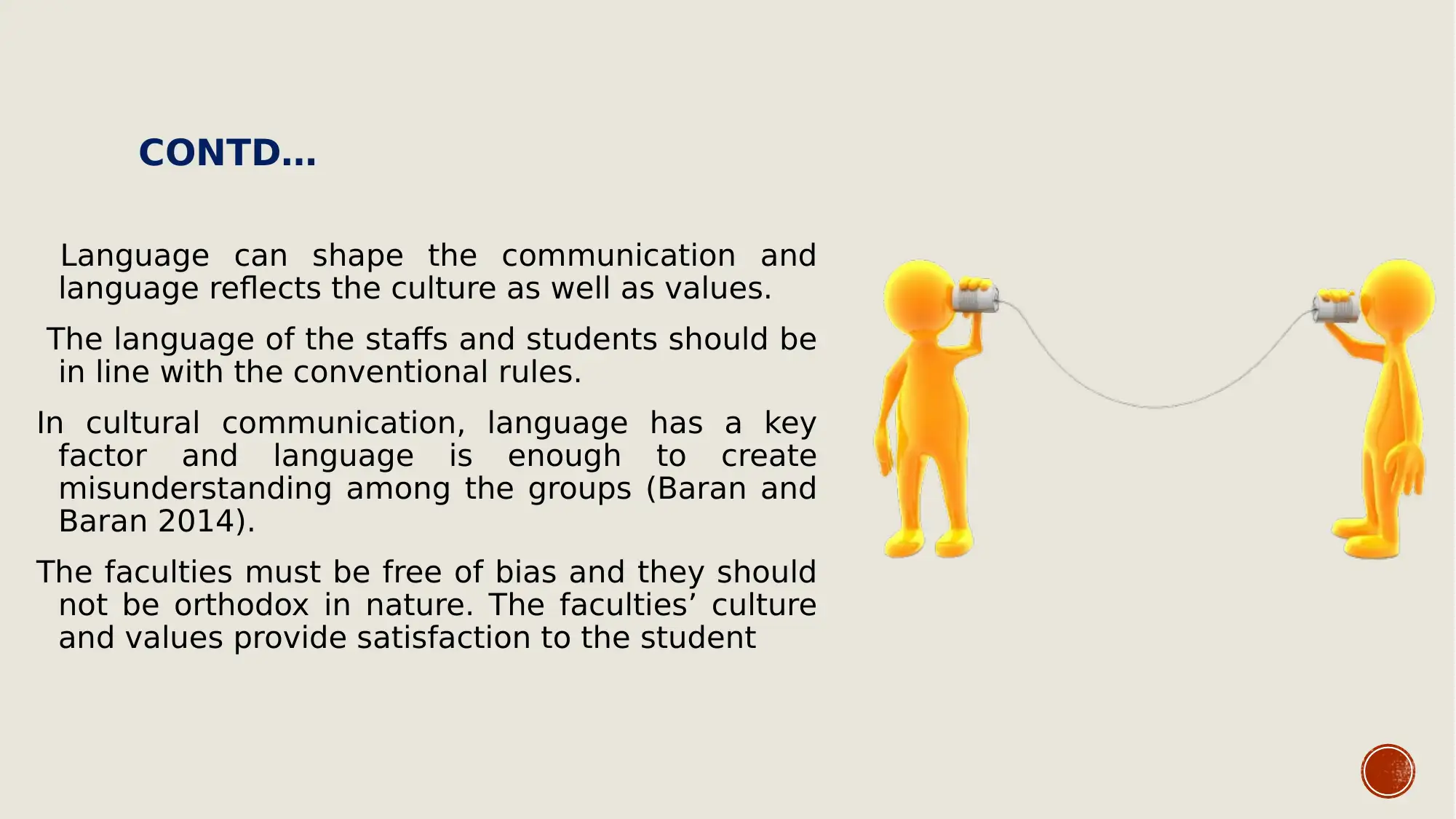
CONTD…
Language can shape the communication and
language reflects the culture as well as values.
The language of the staffs and students should be
in line with the conventional rules.
In cultural communication, language has a key
factor and language is enough to create
misunderstanding among the groups (Baran and
Baran 2014).
The faculties must be free of bias and they should
not be orthodox in nature. The faculties’ culture
and values provide satisfaction to the student
Language can shape the communication and
language reflects the culture as well as values.
The language of the staffs and students should be
in line with the conventional rules.
In cultural communication, language has a key
factor and language is enough to create
misunderstanding among the groups (Baran and
Baran 2014).
The faculties must be free of bias and they should
not be orthodox in nature. The faculties’ culture
and values provide satisfaction to the student
⊘ This is a preview!⊘
Do you want full access?
Subscribe today to unlock all pages.

Trusted by 1+ million students worldwide
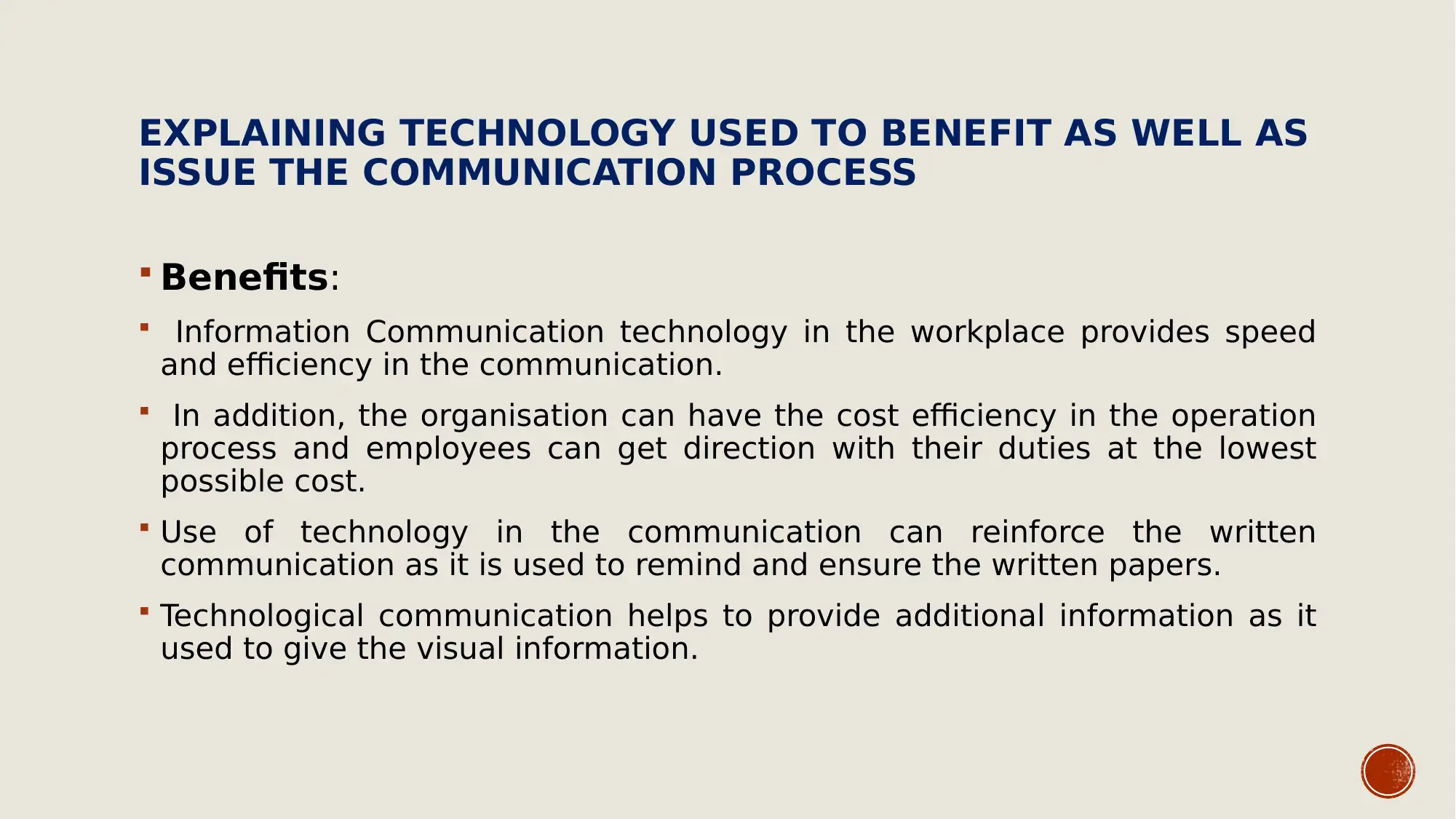
EXPLAINING TECHNOLOGY USED TO BENEFIT AS WELL AS
ISSUE THE COMMUNICATION PROCESS
Benefits:
Information Communication technology in the workplace provides speed
and efficiency in the communication.
In addition, the organisation can have the cost efficiency in the operation
process and employees can get direction with their duties at the lowest
possible cost.
Use of technology in the communication can reinforce the written
communication as it is used to remind and ensure the written papers.
Technological communication helps to provide additional information as it
used to give the visual information.
ISSUE THE COMMUNICATION PROCESS
Benefits:
Information Communication technology in the workplace provides speed
and efficiency in the communication.
In addition, the organisation can have the cost efficiency in the operation
process and employees can get direction with their duties at the lowest
possible cost.
Use of technology in the communication can reinforce the written
communication as it is used to remind and ensure the written papers.
Technological communication helps to provide additional information as it
used to give the visual information.
Paraphrase This Document
Need a fresh take? Get an instant paraphrase of this document with our AI Paraphraser
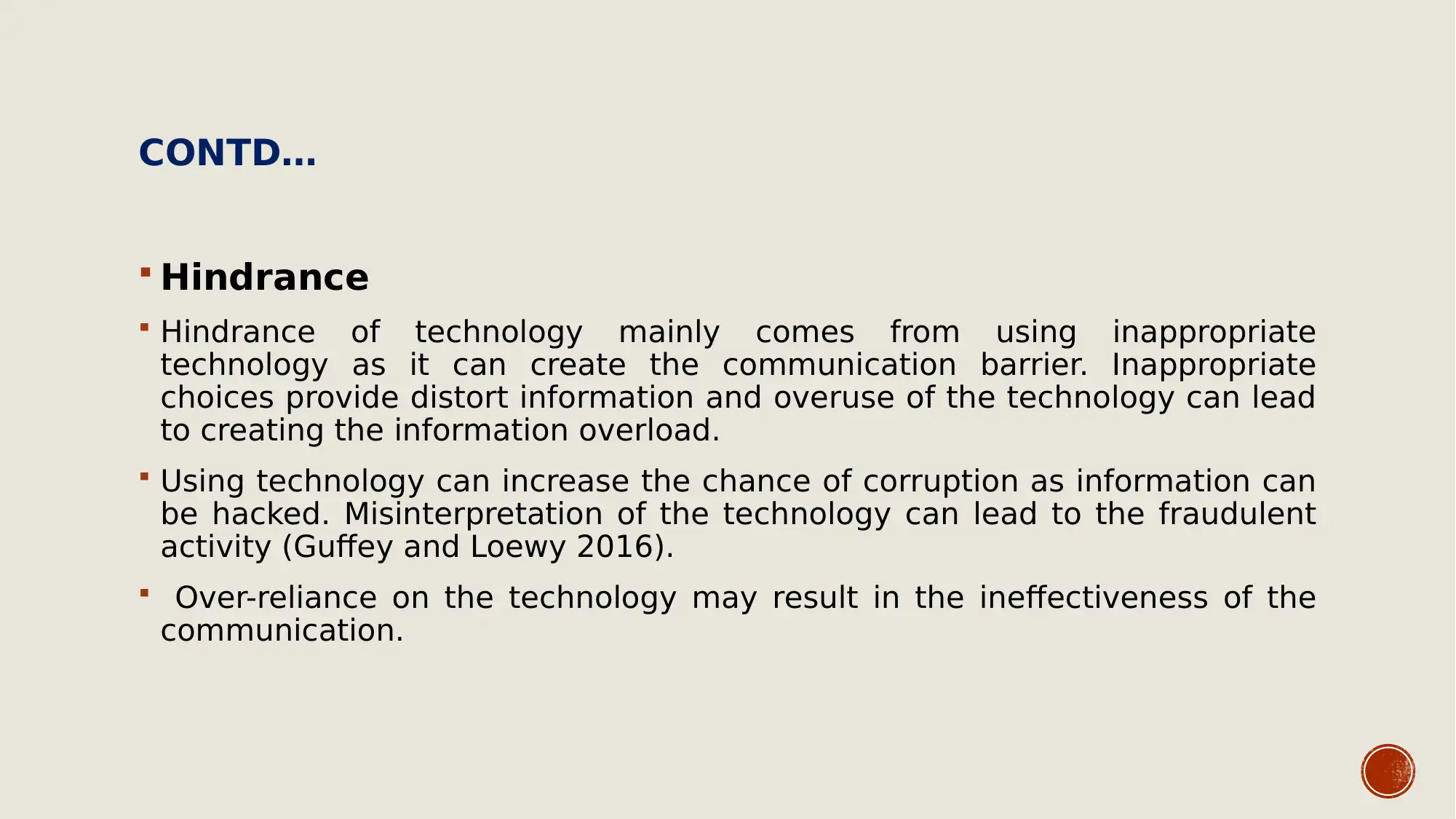
CONTD…
Hindrance
Hindrance of technology mainly comes from using inappropriate
technology as it can create the communication barrier. Inappropriate
choices provide distort information and overuse of the technology can lead
to creating the information overload.
Using technology can increase the chance of corruption as information can
be hacked. Misinterpretation of the technology can lead to the fraudulent
activity (Guffey and Loewy 2016).
Over-reliance on the technology may result in the ineffectiveness of the
communication.
Hindrance
Hindrance of technology mainly comes from using inappropriate
technology as it can create the communication barrier. Inappropriate
choices provide distort information and overuse of the technology can lead
to creating the information overload.
Using technology can increase the chance of corruption as information can
be hacked. Misinterpretation of the technology can lead to the fraudulent
activity (Guffey and Loewy 2016).
Over-reliance on the technology may result in the ineffectiveness of the
communication.
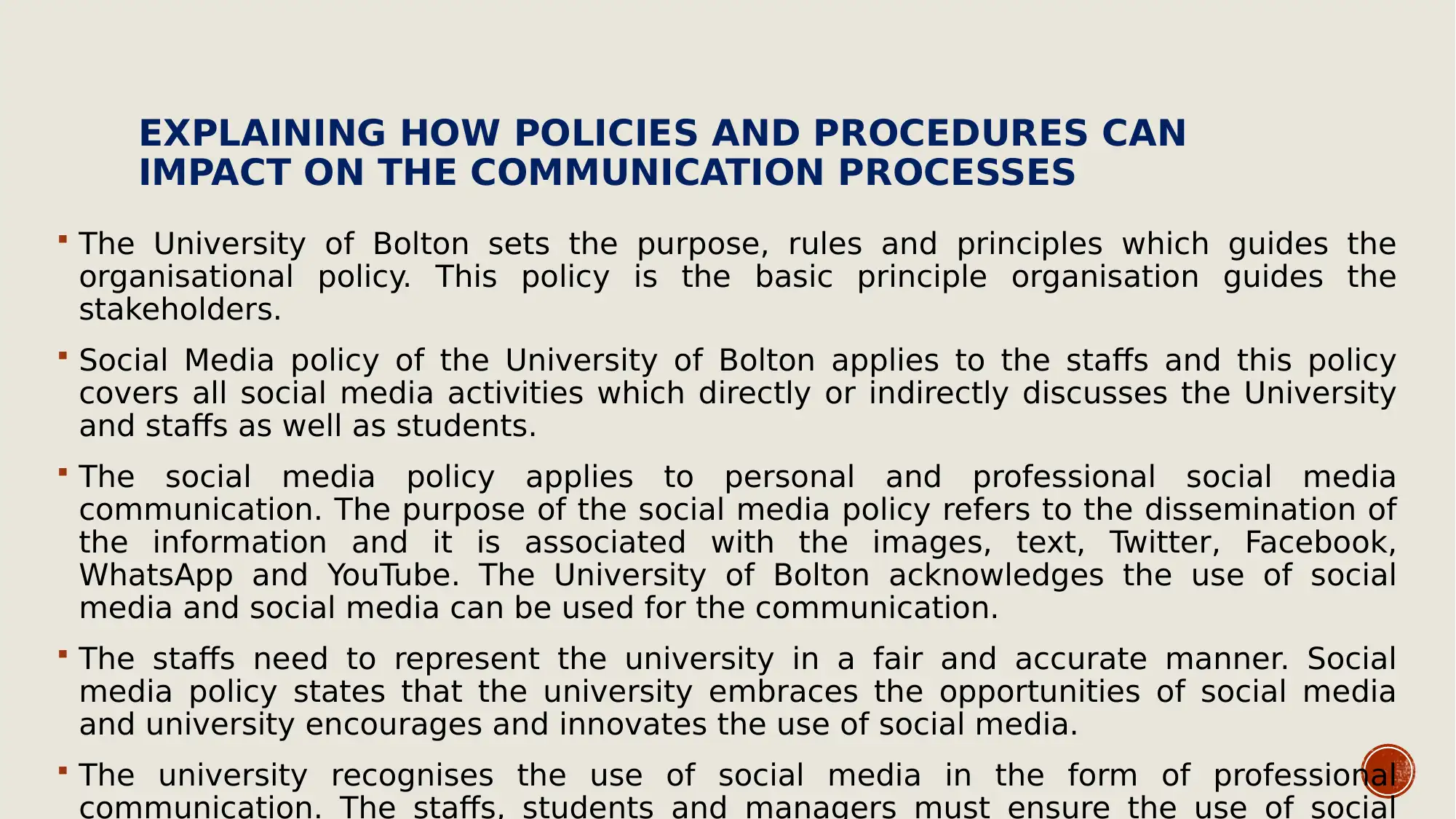
EXPLAINING HOW POLICIES AND PROCEDURES CAN
IMPACT ON THE COMMUNICATION PROCESSES
The University of Bolton sets the purpose, rules and principles which guides the
organisational policy. This policy is the basic principle organisation guides the
stakeholders.
Social Media policy of the University of Bolton applies to the staffs and this policy
covers all social media activities which directly or indirectly discusses the University
and staffs as well as students.
The social media policy applies to personal and professional social media
communication. The purpose of the social media policy refers to the dissemination of
the information and it is associated with the images, text, Twitter, Facebook,
WhatsApp and YouTube. The University of Bolton acknowledges the use of social
media and social media can be used for the communication.
The staffs need to represent the university in a fair and accurate manner. Social
media policy states that the university embraces the opportunities of social media
and university encourages and innovates the use of social media.
The university recognises the use of social media in the form of professional
communication. The staffs, students and managers must ensure the use of social
IMPACT ON THE COMMUNICATION PROCESSES
The University of Bolton sets the purpose, rules and principles which guides the
organisational policy. This policy is the basic principle organisation guides the
stakeholders.
Social Media policy of the University of Bolton applies to the staffs and this policy
covers all social media activities which directly or indirectly discusses the University
and staffs as well as students.
The social media policy applies to personal and professional social media
communication. The purpose of the social media policy refers to the dissemination of
the information and it is associated with the images, text, Twitter, Facebook,
WhatsApp and YouTube. The University of Bolton acknowledges the use of social
media and social media can be used for the communication.
The staffs need to represent the university in a fair and accurate manner. Social
media policy states that the university embraces the opportunities of social media
and university encourages and innovates the use of social media.
The university recognises the use of social media in the form of professional
communication. The staffs, students and managers must ensure the use of social
⊘ This is a preview!⊘
Do you want full access?
Subscribe today to unlock all pages.

Trusted by 1+ million students worldwide
1 out of 14
Related Documents
Your All-in-One AI-Powered Toolkit for Academic Success.
+13062052269
info@desklib.com
Available 24*7 on WhatsApp / Email
![[object Object]](/_next/static/media/star-bottom.7253800d.svg)
Unlock your academic potential
Copyright © 2020–2025 A2Z Services. All Rights Reserved. Developed and managed by ZUCOL.





